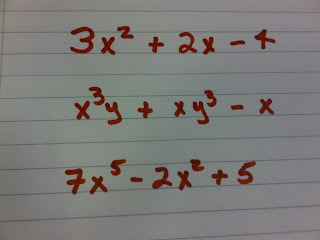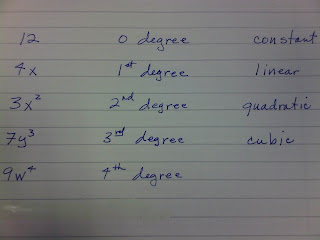Nomial is another name for number or term. Poly means many. A polynomial is many numbers or many terms.
In algebra 1 we work with:
Monomials - - which means one term
Examples:
5
x
12y
-8xyz
Binomials - - which means two terms
Examples:
2x - 6
x + y
-8xyz + 12x
Notice that binomials are in
lowest terms and have no like terms that can be combined.
Trinomials - - which means three terms
Examples:

Each of these polynomials also has a DEGREE (or power). We find the degree by finding the highest power of each term. The term with the highest power sets the degree for the polynomial.
Polynomials can be:

constant
(0 degree)
linear
(1st degree)
quadratic
(2nd degree)
cubic (3rd degree)
4th degree
5th degree
and on and on.

However, the highest degree of a polynomial is the combination of the powers in each individual term.
Standard Form of a PolynomialAs we have learned this year, there are specific ways to write algebraic terms. When writing polynomials we write them from the highest exponent to the lowest exponent.

They are also written in reduced form so all mathematical process that
can be done,
must be done and all like-terms must be combined so the polynomial is in standard form.
Your final answer must be written in standard form, in lowest term.
Adding Polynomials
Adding vertically may be the easiest procedure:

Remember to line up like terms so you are combining like variable with the same exponent.
Subtracting Polynomials
You must remember to distrbute the negative sign into the parentheses.
 Last we look at the signs in the trinomial. The last sign tells us whether the signs in the binomals are the same or different.
Last we look at the signs in the trinomial. The last sign tells us whether the signs in the binomals are the same or different. 























